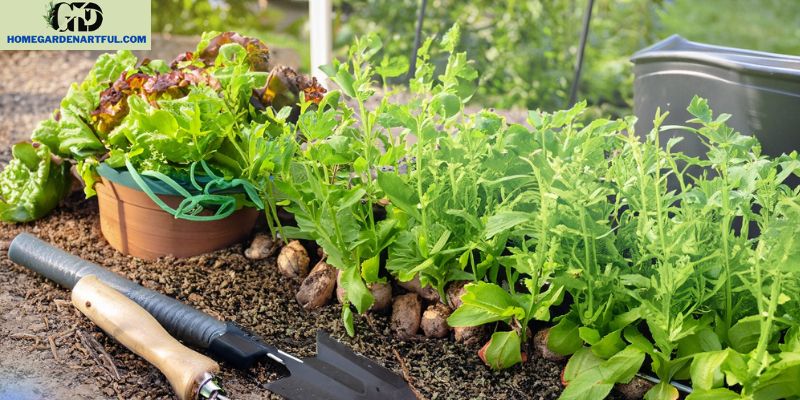Starting a vegetable garden might seem intimidating for beginners, but with the right guidance, it can be an exciting and rewarding endeavor. Welcome to this comprehensive guide, ‘Beginner’s Guide: How to Start a Vegetable Garden,’ where we will walk you through the entire process, from understanding the basics of vegetable gardening to harvesting and storing your homegrown veggies.
We’re here at Homegardenartful.com, your dedicated partner in creating a lush, productive garden. With a wealth of information on various plants, flowers, and gardening techniques, we are committed to helping you nurture a thriving vegetable garden, no matter your level of experience. Whether you’re looking to enhance your garden’s visual appeal or looking for detailed guides on caring for your plants, we’re here to assist you every step of the way.
In this guide, we’ll cover key topics such as the importance of sunlight, water, and location; how to improve soil quality, pest and disease control strategies, and much more. By the end of this article, you’ll have the knowledge you need to start your vegetable garden confidently.
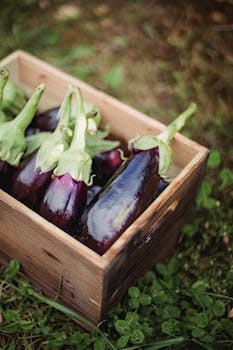
Understanding the Basics of Vegetable Gardening
Embarking on your vegetable gardening journey can be a thrilling endeavor. It’s essential to understand the fundamentals to ensure a successful harvest. Let’s dive into the crucial elements of starting a vegetable garden.
Starting Small and Manageable
When it comes to gardening, the adage “less is more” rings true. It’s better to be proud of a small garden than be overwhelmed by a large one. As a beginner, start with a manageable garden size. For instance, a 10′ x 10′ garden (100 square feet) is an excellent size to begin with. You can choose 3 to 5 of your favorite vegetables and plant 3 to 5 plants of each. Remember, the goal is to enjoy the process without feeling overwhelmed.
The Role of Sunlight, Water, and Location
The location of your vegetable garden plays a crucial role in its success. Most vegetables require 6 to 8 hours of direct sunlight per day. Choose a location that drains well and doesn’t stay wet to prevent root rot. Also, avoid places with strong winds that could damage your young plants.
Improving Soil Quality
Healthy, nutrient-rich soil is the foundation of a prosperous garden. Your soil feeds your plants. If you have thin, nutrient-poor soil, you’ll have weak, unhealthy plants. Improve your soil by mixing in plenty of organic matter. This will aid your plants’ growth and ensure a bountiful harvest.
Pest and Disease Control Strategies
Gardening isn’t just about planting and harvesting. It also involves protecting your plants from pests and diseases. Regularly check your plants for signs of pests or disease. If you spot any, it’s essential to act immediately. For instance, garden pest beetle identification can help you implement effective pest control measures in your garden.
Remember, understanding the basics is the first step towards a successful vegetable garden. In the next section, we’ll explore how to choose the right vegetables for your garden. With these fundamentals in place, you are well on your way to reaping a satisfying harvest. Happy gardening!
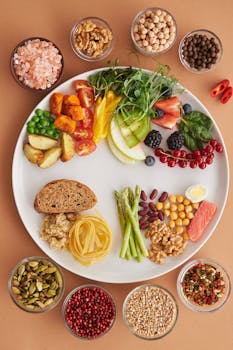
Choosing the Right Vegetables for Your Garden
Ready to cultivate a garden that’s a feast not just for the eyes, but for the palate too? Choosing the right vegetables for your garden is a critical step in your gardening journey. This decision should be guided by personal preferences, local climate, and the quality of seeds.
Grow What You Love
Firstly, think about what vegetables you and your family enjoy eating. There’s no point in dedicating time and effort to grow beetroots if everyone in your household detests them. Plus, the joy of biting into a homegrown tomato or crunching on a fresh carrot that you nurtured from seed is hard to beat.
Remember not to overplant. As every passionate gardener at Homegardenartful.com knows, it’s easy to get carried away with the wide variety of vegetables you can grow. A few tomato plants or a small patch of zucchini might be sufficient to meet your needs throughout the season.
Consider the Vegetable Varieties
Not all tomatoes are created equal. The same goes for peppers, peas, and every other vegetable. There are countless varieties of each vegetable, each with its own growth requirements, flavors, and resistance to pests. Consider these factors while selecting your veggies.
Also, remember to consider the availability of veggies at your grocery store. It might be more rewarding and economical to grow unique varieties of veggies, like tomatillos, that aren’t readily available in your local stores.
Understand the Seasons
Vegetables are broadly classified into cool-season and warm-season crops. Cool-season veggies, such as lettuce, broccoli, and peas, thrive in the cooler weather of early spring and fall. Warm-season veggies, such as tomatoes, peppers, and cucumbers, need the soil to warm up in late spring and summer.
Understanding these seasonal preferences of vegetables is vital to ensure a successful harvest. With staggered plantings, you can enjoy a continuous supply of fresh veggies from your garden.
Choose High-Quality Seeds
Finally, invest in high-quality seeds. While seeds are generally more affordable than individual plants, low-quality seeds can lead to poor germination and disappointing yields. Spending a few extra cents on quality seeds in spring can reward you with a bountiful harvest come fall.
Choosing the right vegetables for your garden is not just about what’s common or popular. It’s about understanding your preferences, the local climate, and the specific needs of each vegetable variety. Armed with this knowledge, you can confidently start your vegetable garden and look forward to a rewarding harvest. Up next, we’ll delve into the exciting world of garden layouts. Stay tuned!
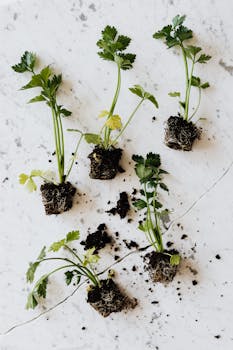
Planning Your Vegetable Garden Layout
Well begun is half done, and nothing sets the stage for a successful vegetable garden like a well-thought-out layout. Whether you’re working with a sprawling backyard or a compact city balcony, effective planning can help you make the most of your space. Here are some key pointers to consider when mapping your vegetable garden.
Deciding on the Size and Location of Your Garden
Start by assessing your space. The size of your garden should be determined by your needs, time, and resources. If you’re a beginner, it’s wise to start small. Remember, a well-tended small garden can produce more than a large, neglected one. As for location, vegetables need at least 6 to 8 hours of direct sunlight a day, so choose a spot with ample light. Don’t forget about water access. The closer your garden is to a water source, the easier it will be to maintain.
Understanding the Concept of Row Cropping vs. Intensive Cropping
When it comes to garden layout, you have a couple of options: row cropping and intensive cropping. Row cropping involves planting in single file rows with space in between for easy access. This traditional method is ideal for large gardens and makes weed control a breeze. On the other hand, intensive cropping is a space-saving technique where plants are grown close together, maximizing yield per square foot. This method is perfect for small gardens, but requires more diligent weed management.
Tips for Maximizing Space in the Garden
To boost your garden’s productivity further, consider vertical gardening. By planting vining crops like beans and peas, you can utilize vertical space and significantly increase yield. Raised beds are another great option for tight spaces. They allow for better control over the soil and can be filled with top-quality garden soil for optimal growth. You can also try the square-foot method, a specialized version of intensive cropping, which involves subdividing a raised garden bed into 1-foot squares for efficient planting.
The Role of Companion Planting in a Vegetable Garden
Don’t forget about companion planting – the practice of planting certain vegetables and herbs together for mutual benefit. This can help deter pests, improve pollination, and maximize nutrient uptake. For example, planting tomatoes with basil can enhance the flavor of your tomatoes while deterring pests. On the other hand, planting carrots and radishes together can help efficiently use space as radishes grow quickly and can be harvested before carrots need more room to grow.
Planning your vegetable garden layout may seem daunting, but remember, it’s all part of the fun. And with the wealth of resources available at Homegardenartful.com, you’re never alone in your gardening journey. So map out your garden, roll up your sleeves, and let’s get planting!
Preparing the Soil for Your Vegetable Garden
The soil is the lifeblood of your garden. The success of your vegetable garden hinges on the quality of your soil. Let’s dig into the crucial steps of preparing your soil for a bountiful harvest.
Test Your Soil for pH and Nutrient Levels
First things first, you need to understand your soil. Soil testing is a crucial step in setting the stage for a successful vegetable garden. It tells you about the pH and nutrient levels of your soil, which directly impacts the health and yield of your vegetables. If you’re unsure of how to go about this, you can send a sample to a state-certified soil-testing lab for analysis. This will help you identify what your soil lacks and what you need to add to create the perfect environment for your veggies.
Improve Your Soil Texture with Organic Matter
Once you know what your soil needs, it’s time to get to work. Whether your soil is too sandy, too clayey, or too silty, one thing remains constant – the need for organic matter. Organic matter, like compost, is the magic ingredient that turns any soil into a productive medium for plants. For sandy soils, compost helps fill in gaps and retain moisture and nutrients. For clay soils, it helps separate the particles for better aeration and drainage.
But how do you use compost? Spread any needed amendments like compost and work them into the soil with a tiller or spade. Be careful not to step on freshly tilled soil, as it can compact it and undo your hard work. Let the bed rest for several days before planting so the amendments can do their work.
Consider Raised Garden Beds
If your soil is too challenging to work with, or if you’re dealing with limited space, raised garden beds might be your solution. With raised beds, you can control the soil and its nutrients more easily. They are also a great way to start a vegetable garden right on your existing lawn. Just line the bottom of frames with several layers of newspaper, then fill with soil. It’s an easy option that requires less digging and can be a real back-saver!
At Homegardenartful.com, we have a wealth of resources to help you understand and improve your soil. With the right preparation and care, your soil can become the perfect home for your vegetables to thrive. So grab your gardening gloves and let’s get your soil ready for planting!
Planting and Caring for Your Vegetable Garden
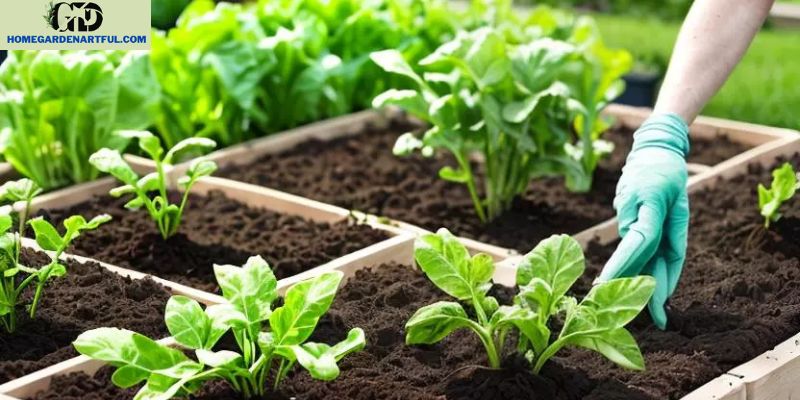
Once your soil is primed and ready, it’s time to bring your vegetable garden to life! This is where the magic truly happens, and where your hard work begins to bear fruit (or vegetables, in this case!).
When and How to Plant Different Vegetables
Not all vegetables are created equal! Some thrive in the cool embrace of early spring or fall, like lettuce, broccoli, and peas. These are what we call “cool-season” vegetables. On the other hand, “warm-season” veggies such as tomatoes, peppers, and cucumbers prefer the sun-kissed soil of late spring and summer.
When planting, keep in mind the specific needs of each vegetable. For instance, tomato plants require deeper holes, while peas need a trellis to climb on. Refer to our detailed Grow Guides at Homegardenartful.com to make sure you’re giving each plant what it needs to flourish.
The Importance of Staggered Plantings for a Continuous Harvest
Imagine having a burst of lettuce all at once and then none for the rest of the season. This is what happens if you plant all your seeds at the same time. Instead, stagger your plantings by a few weeks. This method ensures a steady supply of fresh veggies throughout the season, giving you a continuous harvest to enjoy.
Tips for Watering, Fertilizing, and Weeding Your Vegetable Garden
Gardening is not a plant-it-and-forget-it affair. Regular watering is crucial, especially for thirsty vegetables like cucumbers and squash. As a general rule, water deeply and less frequently to encourage deep root growth.
Fertilizing is equally important. Organic matter added during soil preparation provides a good start, but additional nutrients may be needed as plants grow. Natural fertilizers like compost or manure are great choices.
Don’t forget to weed! Weeds compete with your vegetables for water, nutrients, and sunlight. Regular weeding keeps your garden healthy and ensures your veggies get all they need to grow.
Strategies for Dealing with Pests and Diseases
Even with the best care, pests and diseases can still invade your garden. Regularly inspect your plants for signs of trouble. Handpicking pests or using natural repellents often suffices for small infestations.
For more serious problems, check out our guide on garden pest beetle identification and other resources at Homegardenartful.com. Remember, being proactive is key to a healthy garden!
Planting and caring for your vegetable garden might seem like a lot of work, but the rewards are worth every bit of effort. Remember, the best fertilizer is the gardener’s shadow. So, get out there and give your plants the love they need to grow!
Harvesting and Storing Your Vegetables
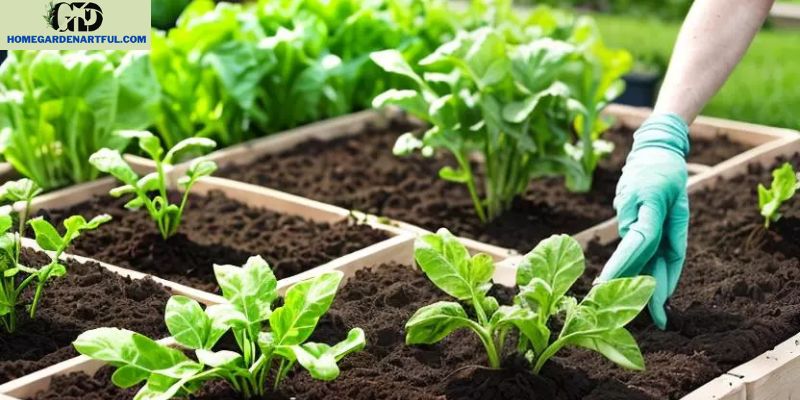
Now that you have successfully planted and nurtured your vegetable garden, it’s time to reap the fruits (or rather, veggies) of your labor. But how do you know when your vegetables are ready to harvest? And how do you store them to keep them fresh for as long as possible? Let’s dive into these key points.
How to Know When Your Vegetables are Ready to Harvest
The peak harvest time for your vegetables can vary greatly depending on the type of vegetable and the specific variety. Some vegetables like radishes and lettuce mature quickly, while others like tomatoes and peppers take longer. Knowing when to harvest your vegetables is crucial for the best flavor and nutritional value.
Generally, vegetables are ready to harvest when they are of a size suitable for eating and are the right color. For example, zucchini is best when about 6 to 8 inches long, and tomatoes are ready when they are fully colored and firm.
Tips for Harvesting Different Vegetables
Harvesting methods can vary among different vegetables. Some vegetables, such as beans and peas, should be picked regularly to encourage further production. Others, like potatoes and onions, are harvested all at once at the end of the season.
When harvesting leafy greens such as lettuce and spinach, pick the outer leaves first and allow the center of the plant to continue growing. For root vegetables like carrots and radishes, gently loosen the soil around the vegetable with a garden fork before pulling it up to prevent damage.
How to Store Your Vegetables for Maximum Freshness
Once you’ve harvested your vegetables, proper storage is key to maintaining their freshness. Most vegetables will keep best in a cool, humid environment. A refrigerator crisper drawer is often an ideal storage spot.
Some vegetables, like potatoes and onions, should be stored in a cool, dry, dark place. Remember not to wash your veggies until you’re ready to use them, as moisture can promote mold growth and speed up spoilage.
Starting a vegetable garden might seem daunting at first, but with help from homegardenartful.com, you’ll be enjoying your own fresh, homegrown produce in no time. Remember, the satisfaction of biting into a juicy tomato or crisp carrot that you’ve grown yourself is worth every bit of effort!
Conclusion
Starting a vegetable garden is more than just a hobby; it’s a rewarding journey towards self-sustainability, a healthier lifestyle, and a deeper connection with nature.
In this comprehensive guide, we’ve covered everything a beginner needs to know to start their own vegetable garden. We’ve discussed the importance of understanding the basics of vegetable gardening, including the role of sunlight, water, location, and quality soil. We’ve highlighted the significance of choosing the right vegetables based on personal preference and suitability to your garden’s conditions.
We’ve also delved into planning your garden layout, preparing the soil, and the essential care routines for your vegetable garden, including watering, fertilizing, and weeding. Finally, we’ve provided you with tips on when and how to harvest your vegetables for maximum freshness, and how to store them correctly.
Gardening is a learning process, and it’s perfectly normal to encounter challenges along the way. Remember, every gardener was once a beginner, and every successful garden started with a single seed. So, don’t get discouraged if your first attempt doesn’t turn out perfectly. With patience, perseverance, and a little bit of love, you’ll soon be reaping the rewards of your hard work.
At homegardenartful.com, our goal is to help you create the garden of your dreams. Whether you’re looking for detailed guides on different plants and flowers, or you need some inspiration for your garden layout, we’ve got you covered. We’re here to provide you with the knowledge and guidance you need to make your gardening journey a successful and enjoyable one.
So, are you ready to get your hands dirty and embark on this exciting gardening adventure? With the right tools, knowledge, and a bit of enthusiasm, you’ll soon be enjoying the fruits (or rather, vegetables) of your labor. Happy gardening!

